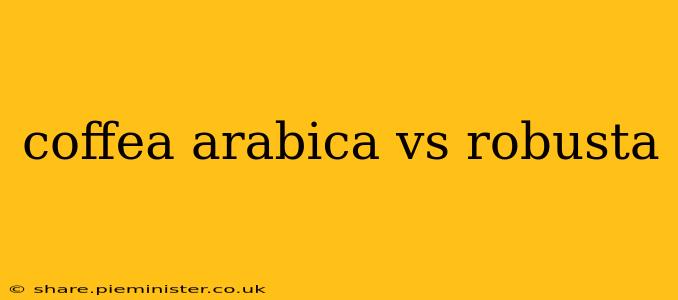Coffee, that magical elixir that fuels billions worldwide, comes primarily from two species: Coffea arabica and Coffea canephora, better known as Robusta. While both contribute to the global coffee supply, they differ significantly in taste, caffeine content, growing conditions, and overall cost. This comprehensive guide explores the key distinctions between Arabica and Robusta beans, helping you better understand your daily brew.
What is Arabica Coffee?
Coffea arabica accounts for approximately 60% of the world's coffee production. Prized for its superior flavor profile, Arabica beans are generally considered to be more aromatic, with notes of sweetness, fruitiness, and acidity. This complex flavor is attributed to a higher concentration of sugars and a wider range of aromatic compounds compared to Robusta. Arabica plants are more delicate and require specific growing conditions—high altitudes, rich soil, and ample rainfall—making them more challenging and expensive to cultivate.
What is Robusta Coffee?
Coffea canephora, or Robusta, makes up a significant portion of the remaining global coffee production. While often considered inferior in terms of flavor complexity compared to Arabica, Robusta possesses a bolder, more bitter, and sometimes earthy taste. Its distinctive characteristic is its significantly higher caffeine content, making it a popular choice for espresso blends and instant coffee. Robusta plants are more resilient and adaptable, thriving in hotter and lower altitudes with less demanding soil conditions, contributing to its lower production cost.
Arabica vs. Robusta: A Head-to-Head Comparison
| Feature | Arabica | Robusta |
|---|---|---|
| Taste | Sweet, fruity, acidic, aromatic | Bitter, earthy, strong, nutty |
| Caffeine | Lower (0.8-1.5%) | Higher (2.0-2.5%) |
| Growing Conditions | High altitudes, specific climate | Hotter climates, less demanding conditions |
| Price | Higher | Lower |
| Acidity | Higher | Lower |
| Body | Lighter | Heavier, more full-bodied |
| Cultivation Difficulty | More challenging | Easier |
What are the main differences in taste between Arabica and Robusta coffee beans?
Arabica beans offer a nuanced and complex flavor profile with a wide spectrum of tasting notes, ranging from sweet and fruity to floral and chocolatey. Robusta, on the other hand, delivers a more robust and intense flavor with a pronounced bitterness and earthy undertones. The distinct taste differences stem from the variations in chemical composition between the two bean types.
Which coffee bean has more caffeine?
Robusta beans have significantly more caffeine than Arabica beans. This higher caffeine content is a key factor in its use in espresso blends, where the caffeine boost is desirable. The caffeine difference is attributable to the genetic makeup of the plants themselves and contributes significantly to the perceived energy levels after consuming each type of coffee.
Which coffee bean is more expensive?
Arabica beans are generally more expensive than Robusta beans. This price difference is directly related to the higher cost of cultivation. Arabica's delicate nature necessitates specific environmental conditions, meticulous care, and often higher labor costs, driving up the overall price. Robusta's hardy nature and adaptability translate to lower production costs.
Which coffee bean is better for espresso?
While both Arabica and Robusta are used in espresso blends, the choice often depends on the desired taste profile. Robusta's higher caffeine content and full body contribute to a stronger, more intense espresso, whereas Arabica may lend more nuanced flavors and a smoother texture. Many high-quality espresso blends utilize a combination of both bean types to achieve a balanced result, leveraging the strengths of each.
Which coffee bean is better for drip coffee?
For drip coffee, the preference is often driven by individual taste. Arabica beans are typically favored for their more balanced and nuanced flavor profile, which is better showcased in a drip brewing method. However, a well-prepared Robusta drip coffee can offer a more intense and bolder experience for those who enjoy that style.
This detailed comparison provides a clearer understanding of the distinctions between Arabica and Robusta coffee beans. Ultimately, the "better" bean is subjective and depends entirely on personal preference. Experimenting with different types and blends allows you to discover your own favored coffee experience.
